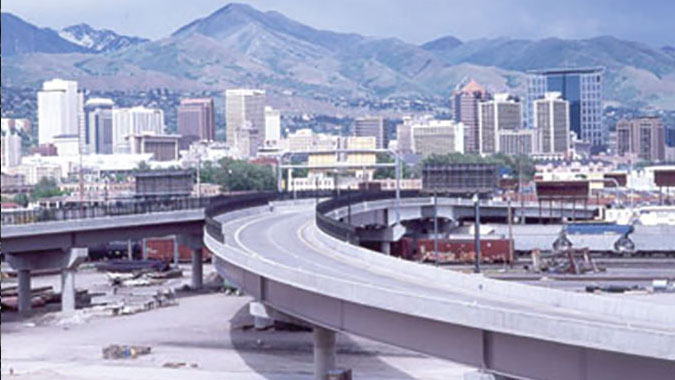
photo credit: Utah Department of Transportation
| Location | Salt Lake City, Utah |
|---|---|
| Project Sponsor / Borrower | Utah Department of Transportation |
| Program Areas |
|
| Mode | Highway |
| Description | The Interstate 15 reconstruction was the Utah Department of Transportation's (UDOT) first design-build procurement. The project involved the reconstruction of 16.2 miles of interstate mainline and the addition of new general purpose and high-occupancy-vehicle (HOV) lanes through the Salt Lake City metropolitan area. The project also included the construction or reconstruction of more than 130 bridges, the reconstruction of seven urban interchanges, and the reconstruction of three major junctions with other interstate routes, including I-80 and I-215. In addition, the project provides for the construction of an extensive region-wide advanced traffic management system. UDOT's decision to use the design-build model was motivated by two factors. The first was the strong public support for completing the project as soon as possible to minimize the period of severe traffic congestion resulting from the diversion of more than half of the traffic from I-15 during the construction period. The second factor was the need to have the project completed before the 2002 Winter Olympics in Salt Lake City. It was generally accepted that use of the design-build contracting methodology was the only way to satisfy these goals. The design-build approach also relieved UDOT of many problems associated with the coordination of the design and construction of multiple individual projects in a congested urban setting. The state procurement laws were modified to clearly authorize the use of the design-build method of contracting and to permit the award of a contract to a firm that provided the "best value" proposal to the state even if another firm bid a lower initial cost. |
| Cost | $1.63 billion |
| Funding Sources | Federal funds - $448 million State/local funds - $1.184 billion |
| Project Delivery / Contract Method | Design-Build contract, best value award. |
| Private Partner | Design-builder - Wasatch Constructors - Joint venture of Peter Kiewit Sons' Inc., Granite Construction Company, Inc. and Washington Construction Company |
| Project Advisors / Consultants | Parsons Brinckerhoff - program management |
| Lenders | None |
| Duration / Status | Construction began in April 1997 and was completed in July 2001 |
| Financial Status | Paid |
| Innovations | The project was approved by the Federal Highway Administration (FHWA) as an experimental project under SEP-14. This approval permitted the use of the design-build method and required some deviations from normal federal-aid requirements dealing with the selection of contractors and consultants. The I-15 design-build contract included provisions for payments of up to $50 million incentive bonuses for timely performance, quality of work, complying with project management requirements, community relations, and maintenance of traffic. While this approach was attractive to the owner, it created problems for the contractors who were not accustomed to bidding for work that would be performed up to 25 years later. When efforts to sufficiently raise the comfort level of the proposers failed, the maintenance period was reduced to a maximum of 10 years - an initial five-year maintenance option and five one-year renewable options covering years six through 10. Maintenance requirements and standards were restricted to pavement surfaces, structures, and drainage facilities and did not include any routine maintenance activities. The use of performance specifications, as opposed to traditional prescriptive specifications, encouraged innovation in design and construction. A long contractor warranty or maintenance-after-construction period complements the use of performance specifications by compelling the design-builder to complete life-cycle-cost analyses of all design and construction options. UDOT also derived approximately $30 million in savings by utilizing an Owner Controlled Insurance Program (OCIP). The UDOT wrapped OCIP included pre-construction survey, workers' compensation, general liability, and other miscellaneous coverage for all contractors working on the project. In exchange, the contractor was required to prepare a very extensive safety plan and submit it for approval early in the life of the contract. As an additional safety incentive, they received a share of all insurance premium rebates received after completion of the project. The OCIP was funded entirely with State monies through a separate procurement. |
| Related Links / Articles | UDOT I-15 Test Bed Reports OIG Audit Report Utah's I-15 Design-Build Project |
| Contacts | Not available |